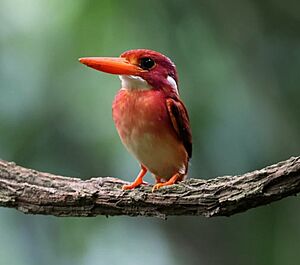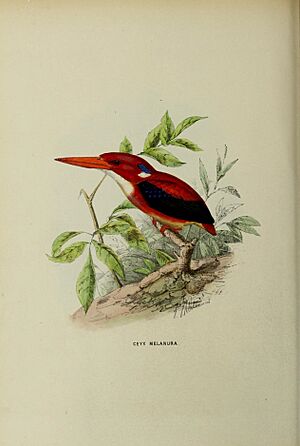Philippine dwarf kingfisher facts for kids
Quick facts for kids Philippine dwarf kingfisher |
|
|---|---|
 |
|
| A South Philippine Dwarf Kingfisher in Cagayan de Oro | |
| Conservation status | |
| Scientific classification | |
| Genus: |
Ceyx
|
| Species: |
melanurus
|
The Philippine dwarf kingfisher (Ceyx melanurus) is a tiny, colorful bird found only in the Philippines. It belongs to the Alcedinidae family, which includes all kingfishers. This special bird lives in tropical lowland forests. You can find it on islands like Luzon, Polillo Islands, Catanduanes, Basilan, Samar, Leyte, and Mindanao. Sadly, its home is shrinking because of habitat loss.
About the Philippine Dwarf Kingfisher
The Philippine dwarf kingfisher is a small bird, mostly bright orange. It has a red beak and red legs. Its belly is white.
Some of these kingfishers have a light purple color, which is stronger in the birds from the southern islands. Birds from the northern islands have dark blue spots on their wings.
A German scientist named Johann Jakob Kaup first officially described this bird in 1848. He gave it the scientific name Alcedo melanura. The name melanurus comes from an old Greek word meaning "with a black tail." Today, this kingfisher is placed in the Ceyx group of birds.
Different Types of Philippine Dwarf Kingfishers
There are three main types, or subspecies, of the Philippine dwarf kingfisher:
- C. m. melanurus: Found in northern Philippines, on islands like Luzon, Polillo, Alabat, and Catanduanes.
- C. m. samarensis: Found in the central Philippines, on Samar and Leyte islands.
- C. m. mindanensis: Found in the southern Philippines, on Mindanao and Basilan islands.
Sometimes, the C. m. mindanensis subspecies is seen as its own separate species. It is then called the South Philippine dwarf kingfisher (Ceyx mindanensis). The other two types (melanurus and samarensis) are then called the North Philippine dwarf kingfisher.
These two proposed species look a bit different. The North Philippine dwarf kingfishers have dark blue spots on their wings and near their ears. They are also a little smaller. The South Philippine dwarf kingfishers have a more noticeable purple color. They are also more orange all over.
In March 2020, a young South Philippine dwarf kingfisher was photographed for the very first time. This exciting photo was taken in Cagayan de Oro.
Where They Live and How They Are Protected
The Philippine dwarf kingfisher lives in lowland primary (old growth) and secondary forests. These are forests that have grown back after being cut down. They can be found up to 750 meters (about 2,460 feet) above sea level. They like places that get a lot of rain.
The IUCN Red List is a list that shows how endangered animals are. It looks at the North and South types of the Philippine dwarf kingfisher separately. Both types are considered vulnerable. This means their populations are decreasing.
The South Philippine dwarf kingfisher has a smaller population. There are likely only 2,500 to 9,999 adult birds left. The North Philippine dwarf kingfisher has more, with an estimated 10,000 to 19,999 adults.
The biggest danger to these birds is habitat loss. Their forest homes are being cleared away. This happens because of logging, farming, and mining.
Right now, there are no special plans just for saving these kingfishers. However, they do live in some protected areas. These include the Northern Sierra Madre Natural Park, Bataan National Park, Samar Island Natural Park, and Mount Kitanglad National Park. But even in these protected places, logging and hunting can still be a problem.



